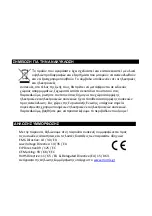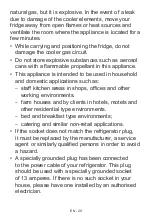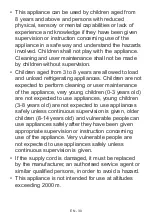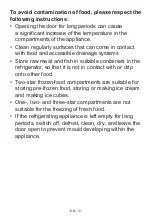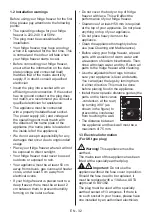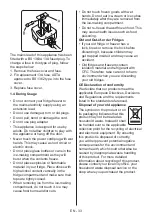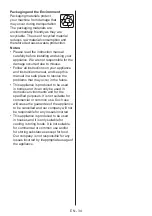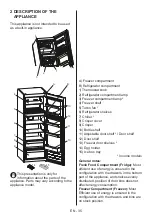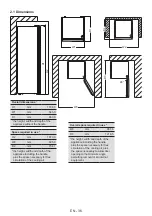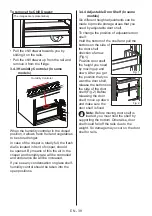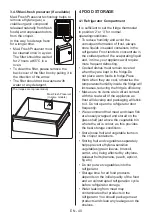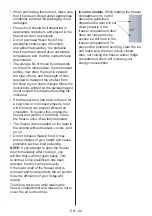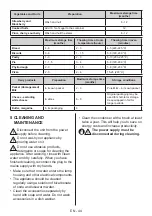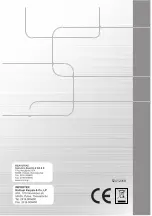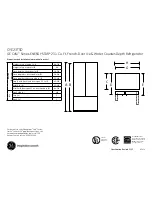
EN - 37
3 USING THE APPLIANCE
3.1 Information about New Generation
Cooling Technology
Fridges with new-generation cooling
technology have a different operating
system to static fridges. Other (static)
fridges may experience a build up of ice
in the freezer compartment due to door
openings and humidity in the food. In such
fridges, regular defrosting is required; the
fridge must be switched off, the frozen
food moved to a suitable container and
the ice which has formed in the freezer
compartment removed.
In fridges with new-generation cooling
technology, a fan blows dry cold air
evenly throughout the fridge and freezer
compartments. The cold air cools your food
evenly and uniformly, preventing humidity
and ice build-up.
In the refrigerator compartment, air
blown by the fan, located at the top of
the refrigerator compartment, is cooled
while passing through the gap behind
the air duct. At the same time, the air is
blown out through the holes in the air duct,
evenly spreading cool air throughout the
refrigerator compartment.
There is no air passage between the
freezer and refrigerator compartments,
therefore preventing the mixing of odours.
As a result, your fridge, with new-
generation cooling technology, provides
you with ease of use as well as a huge
volume and aesthetic appearance.
3.2 Thermostat Setting
The appliance thermostats automatically
regulate the temperature inside the
compartments. Rotate the knob to a higher
position, from 1 to 5, to obtain colder
temperatures. During cooler seasons, set
the thermostat to lower positions to reduce
energy consumption.
Lamp cover
Thermostat knob
Super switch /
Low ambient Switch
(In some models)
(The images are representative)
Thermostat settings:
1 – 2 :
For short-term storage of food in the
freezer compartment.
3 – 4 :
For long-term storage of food in the
freezer compartment.
5 – MAX :
For freezing fresh food. The
appliance will work longer. Once the food
is fully frozen, reset the thermostat to its
original position.
3.3 Temperature Settings Warnings
•
Your appliance is designed to operate in
the ambient temperature ranges stated
in the standards, according to the climate
class stated in the information label. It
is not recommended that your fridge is
operated in the environments which are
outside of the stated temperature ranges.
This will reduce the cooling efficiency of
the appliance.
•
Temperature adjustments should be
made according to the frequency of
door openings, the quantity of food kept
inside the appliance and the ambient
Summary of Contents for W71411NFD
Page 1: ...W71411NFD REFRIGERATOR USER MANUAL...
Page 2: ...EL 1...
Page 4: ...EL 3 1 1 1...
Page 5: ...EL 4 R600a R600a...
Page 6: ...EL 5 13 8 3 8 0 3 3 8...
Page 7: ...EL 6 8 14 2000...
Page 8: ...EL 7...
Page 9: ...EL 8 1 2 220 240 V 50 Hz AC 50 cm 5 cm 2 cm 150 mm 90 75 mm...
Page 10: ...EL 9 1 3 13 A ASTA BS1362 13 BS 1363A 13A 1 2 13 A ASTA BS 1362 3 1 4...
Page 11: ...EL 10 CFC CE...
Page 12: ...EL 11 2 1 2 3 5 4 6 7 8 9 10 11 12 13 A B 14 15 A B 1 2 3 4 5 6 7 8 9 10 11 12 13 14 15...
Page 14: ...EL 13 3 3 1 3 2 1 5 Super 1 2 3 4 5 MAX 3 3...
Page 16: ...EL 15 3 4 2 0 C 3 4 3...
Page 18: ...EL 17 4 4 1 2 3 4 C 0 8 C 0 C 8 C...
Page 19: ...EL 18 1 2 3 3 4 1 1 2 4 2 18 20 o C 3...
Page 20: ...EL 19...
Page 23: ...EL 22 5 1 LED LED LED LED E LED LED F 6 6 1 6 2...
Page 24: ...EL 23 7...
Page 25: ...EL 24 5 8 1 2 3 4 5 6 7...
Page 51: ......
Page 52: ...52412318...



